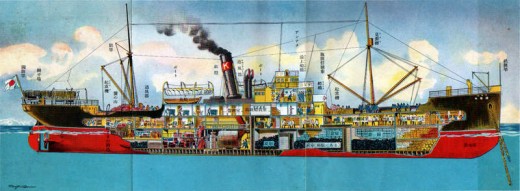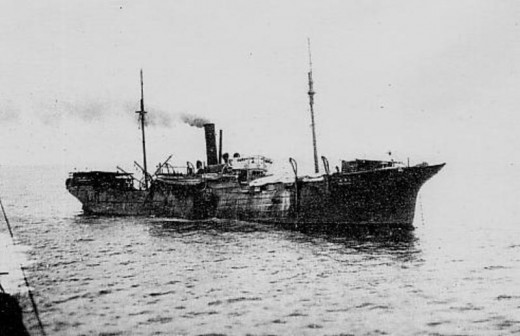Le Bateau-usine: Reviewing the Red Portrait of its Age

Most novels are based around what is fundamentally a rather simple idea: a fictional narrative which typically follows a rather discrete cast of characters, and most often that there is some sort of story to confront, quite commonly with a challenge to overcome or some sort of story that is experienced by the characters. Le Bateau-usine, known in English as the Crab Cannery Ship and in its native Japanese as 蟹工船, and written by Takiji Kobayashi in 1929, is loyal to the first and last concepts, but it diverges dramatically with its collection of characters, as rather than simply pursuing the lives of a single or even group of characters, it has no real unified central character group, but rather focused on the actions of the entire crew of a Japanese crab canning factory ship on their woeful voyage in the Kamchatka seas in the 1920s. This perspective of the story and how it passes is both enriched and rendered dramatically different from a regular novel by this, both its strength and its Achilles heel, and it defines its very nature.
What exactly is the story of this book, of this recounting which follows the path of this heterogeneous collection of fishermen, students, farmers, flotsam and jetsam collected from all across Japan and set adrift on the sea, in this heaving boat which traverses the stormy foam-capped waves in the cold waters to the north of Japan, in their perilous search for crab? It follows this collection of characters, as they face dangers which stem not so much from the harsh environment, freezing and blasted by tempests, but rather from the evident danger of the capitalist system and its oppression, which drives them in some cases to death, and in all to complete and utter human misery, ultimately leading to the natural reaction: resistance. The book's fundamental core element is an examination, an exposé, of the life of these fishermen, and what results in their stand against the system that inflicts upon them such savage barbarism. Along the way, there are characters who jump out at us, although never with a name: "the stammerer", "don't bring them back", "the student", but ever so rarely names, with only Shibaru appearing as a lonely name among the heroes, to match the name of Asakawara for the evil company agent. This does not mean that the workers are interchangeable or a faceless conglomeration, for by contrast there are rich differences among them, in their responses, in their actions, a clear characterization - but never is there an individual who is the singular focal point of a narrative around which the story revolves.

Instead, the fous on the collective is something which places their united misery into context, and which makes their ultimate resistance an organic, natural, reaction, rather than something which is purely the product of a singular individual. The book focuses on the stories of these fishermen in magnificent detail, particularly in their dormitory, named quite literally the "merdier", or the shithole, or shitbox, in the book. Here, workers are crowded in in horrifying numbers into a cramped, dismal, disease ridden, cold, environment, where a poor excuse for a fireplace sends flames dancing upon the walls, while clothes dry over it and the swarming masses of bugs fall upon its burning surface to scorch and fill the room with the stench of burning meat - a far cry from the luxurious fare served to military officers and captains when they come aboard. The book pulls no punches concerning the difficulties of life onboard, and sometimes it can go almost to the point of being disconcerting, as in relating the sexual abuse of younger members of the crew by the older members, the development of homosexual exchanges, and the ways in which men took pleasure when they had not seen women for months upon months. To my understanding, Japan is known for a certain greater openness concerning discussion of such affairs, although I know so catastrophically little I hesitate to comment upon whether that is so, so perhaps it speaks to it: the question is how to interpret it. To me, the author writes without a polemical prose, to simply observe the facts as they are related, while for the Western eyes of this time, this can point to another sign of moral perversion brought about by the punishment of the capitalist system which drives men to what would be seen as unnatural acts.
Perhaps most horrible is the description of the insects, the fleas, the lice, onboard, as mentioned in the previous paragraph.
Avant de dormir, les hommes ôtaient leurs chemises de tricot ou de flanelle, rêches et informes à forces d'être crasseuses. On aurait dit des calamars séchés. Ils les étalaient sur le poêle puis s’asseyaient tout autour, chacun soulevant un bout de vêtement, comme on le fait en famille avec la couverture de la table chauffante. Quand les vêtements étaient chauds, ils les secouaient. Des poux et des punaises combaient alors sur le poêle avec un petit bruit sec et une odeur forte de chair humaine grillée.
"Eh! Tu me tiens l'autre bout?" Un pêcheur tendait une extrémité de son pagne étalé au-dessus du poêle, pour en retirer les poux.
Le pécheur ouvrait la bouche et écrasait bruyamment les poux entre ses dents. A force d'en écraser entre ses pouces, il avait aussi les ongles tout rouges. il essuyait furtivement ses doigts souillés sur le bas de sa veste, comme font les enfants quand ils ont les mains sales, et aussitôt en écrasait un autre. - Malgré tous ces efforts, ils ne pouvaient toujours pas dormir. Toute la nuit, ils étaient persécutés par des poux, des puces, des punaises qui sortaient d'on ne sait où. Ils avaient beauc inlassablement repousser leurs assauts, c'était sans fin. Debout dans les couchettes sombres et humides, ils voyaient aussitôt rappliquer des dizaines des puces qui leur grimpaient sur les jambes. C'était à se demander si leur propre corps n'était pas en train de pourrir, au bout du compte. Ca faisait une drôle d'impression quand même, d’être en quelque sorte devenu un cadavre en décomposition, rongé par la vermine.
When even the bodies themselves thus begin to dissolve under the corruption - and what does the human soul fear more than the corruption brought about by disease, by the infection of insects, by the obliteration of purity? - then things have clearly gone very wrong indeed in society.
These descriptions are not byzantine ones, not prone to run upon pages to pages, in great rolling walls of text. By contrast, there is a certain spartan discipline to the text, a careful selection of words, each one carefully chosen, but direct and straightforward in a way which other books prefer to not economize. This seems perhaps to be, to be a feature of Japanese writing: of the three books I have read, two in English and one in French in Japanese, Musui's Story, The Sound of Waves, and now Le Bateau-usine, the same uncluttered prose and text is a stark companion each time: it is beautiful, but in a sleek way, rather than the great rolling waves which many other classics will throw upon oneself. But these descriptions make the horror on the ship all the more terrible in the clarity of the words and the starkness of the description.

This outlook and story is one which enables one to well see the influence of the outlook and the beliefs of Japanese communism in the 1920s: the book was after all, written by Takiji Kobayashi, a militant Japanese communist who was later killed by the Japanese government. Some obvious aspects appear, such as the focus on the horror of the living conditions into which sailors were plunged, and on the greed and search for profits on the part of the company owning the ship. Other ones are familiar themes but still fascinating ones: the usage of patriotism as a way to fool and trick workers into continuing to work for the greedy profits of the big bosses, as they are routinely assured that by working in such a frenetic and unhealthy way in the northern seas, they were engaging in a patriotic rivalry against the Soviet Union. The actual Russians, when encountered, turn out to be entirely decent and normal people - showing that this perceived rivalry between nations was nothing more than a capitalist scheme all along. Similarly the company is in an alliance with government, attested both by the government's military support, and by the known intention of the company boss to enter politics, on the back of the profits wrung from the blood and tears of the oppressed proletariat - what a woeful condemnation of a government controlled and bought by the bourgeois! The big bosses aim to recruit labor which is docile, but in fact, according to Takiji, this conversely only serves to further spread the fire of class consciousness, as these "reliable", workers, subjected to such appalling conditions, forge new ties and links. Their very presence in this northern region speaks to a firm belief in the tendency for the rates of profit to call, driving capital in the search of new and virgin soil or waves - be it Hokkaido with its farms filled with dispossessed and oppressed peasant farmers, who work heroically only to see their land stolen from them by the banks, or the fishermen who are sent north to engage in the untapped waters off Sakhalin, reaping huge profits for the company and none for them. Others are more peculiar to the Japanese situation, such as the firm belief on the part of the Japanese workers that the Emperor will look out for them, and their hope for petition for redress from him. Their fervent hopes are laid too upon the military, which they firmly believe to be on their side: these velleities are shattered when the soldiers turn their bayonets on the workers. Perhaps there is even a vague sense of loss for tradition, as it is now the company's inspector who rules the boat, and who overrules consistently the decisions of the captain, who in older years would have been his own man, the master of his own house. But perhaps the most important is the fundamental belief that only in united and collective action can the workers overcome, and that ultimately, once they join together as a great mass, a single front, without divisions, they can defeat the agents who rule over them. If it was not clear enough from the story, occasional elements of narrative affirmation echo this, remarking upon these points.
Which is I believe, where the book and its audience must meet their reconciliation: as a tome devoted above all else to a social milieu: for those who have the expectation of a traditional novel, based upon its singular character, a traditional hero, Le Bateau-usine appears alienating, bizarre. But as a commentary on the time, upon its mentalities, upon the way of life of the Japanese industrial proletariat, of the ideas of Japanese communism and their reflection upon Japanese society and its flaws, the openings they perceived for their movement to succeed and yet also its peculiarities and nodes of resistance which kept the working class in its perceived chains, it is one which is emblematic of the time - and in a further sense, also timeless, as many of the worries, problems, and traps which it perceived as ensnaring the Japanese workers of the 1920s, are ones which are still universally present. The lessons and the moral fervor present in the book are ones which are still clear and visible today, and have led to its republication not long ago. For the combination of this revealing light, its depiction of working life, of Japan in the 1920s, and the elegance of its sparse and uncluttered style, it makes a book well worth reading, but with the understanding that the book into which one plunges is far removed from that of the normal fare of novels.
© 2019 Ryan Thomas









